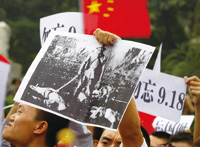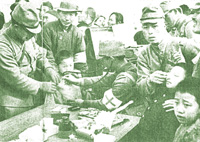How to Rebuke an Insolent Nation!
Wake Up, Land of the Samurai
There Was No Nanking Massacre

Japanese Society for History Textbook Reform
Nobukatsu Fujioka, Director
Born in Hokkaido in 1943. Educator. Director of Japanese Society for History Textbook Reform. Visiting professor, Takushoku University. Established ‘Liberal Historical View Study Group’ in 1995 after serving as Associate Professor at Hokkaido University of Education and Professor at Tokyo University in order to reform Japan’s deflected history education. Joined the ‘Japanese Society for History Textbook Reform’ in 1997. Author of many books including ‘Kokkyo no shima wo hakken shita nihonjin no monogatari’ [‘The Story of the Japanese who Discovered the Island on the Border’] (published by Shodensha) and ‘Jigyaku shikan no byouri’ [Pathology of a Masochistic View of History’] (published by Bungei Shunju).
The basis for the masochistic view of the history of Japan is centred on the issues of the ‘Nanking Massacre’, when the Japanese army conducted genocide during the Sino-Japanese war and ‘comfort women’, where Korean women were forced to become ‘sex slaves’ for Japanese soldiers. Did these things really take place? We asked Nobukatsu Fujioka, Director of the Japanese Society for History Textbook Reform, for the latest results of his research.
Kuomintang Troops Massacred Many Deserters
Nanking fell on the 13th of December in 1937. Looking at evidence from burial records and the like, it seems that about fifteen thousand Chinese Kuomintang troops and several thousand Japanese soldiers were killed.
The citizens began evacuating to the surrounding farm villages from the beginning of autumn. The reason for this was that they were certain that the Japanese army would invade Nanking after winning the battle waged with the Chinese Kuomintang army in Shanghai. Although the city had a population of one million people prior to the war, Nanking was decimated to about 200,000 at the time of its fall.
Nanking had a wealth of valuable cultural heritage. Therefore, the Japanese army recommended to the Kuomintang that they surrender peacefully when they besieged the city. However, this proposal was ignored so fighting became inevitable. The Kuomintang army’s chain of command had collapsed because commanders had made their escape. Deserters were shot as punishment, and the Nanking castle was filled up with dead soldiers.
The 20,000 Kuomintang soldiers remaining in the city changed out of their uniforms and into civilian clothes, and they sneaked into the security zone. It was a place in the city where surviving citizens sheltered under the control of fifteen Westerners. But those foreigners could not prevent the invasion of soldiers into the zone because they were not armed, and it became a military base for the guerrillas. The Japanese army executed about 6,500 Chinese, including some who resisted in vain, in a search-and-destroy operation. International law prohibited guerrillas from wearing civilian clothes as a disguise. Thus, the Westerners and citizens did not dispute these executions.
Only 26 Cases of ‘Murder’ Were Reported by Hearsay

The ‘Nanking Massacre' provided material for ‘denouncing Japan' at the anti-Japan demonstrations.
It is inconceivable that there was a major outbreak of rapes committed by the Japanese army. The Japanese knew which squads were stationed where, and they also knew that the security zone was off limits. Moreover, Nanking had a blackout until the end of the year. Japanese soldiers, who were not familiar with the local area, could not prowl around. Any incidents of rape and looting would have been committed by Chinese soldiers. In China, since long before, soldiers had always been a collection of rogues who were accustomed to taking advantage of people by looting and raping. The citizens of Nanking welcomed the Japanese army when they kicked the Kuomintang soldiers out as ‘peace was restored’. In fact, one month after the Japanese occupation, the population of Nanking increased.
The Comfort Women Issue Is a Fiction Propagated by the Left Wing in the 1990’s

In the city of Nanking after the fall, citizens were given medical treatment by the Japanese army. The Japanese army was committed to protecting the citizens of Nanking.
One reason why the Japanese believed this hoax was that there was a widely propagated theory that the Koreans in Japan were those forced to come from the Korean Peninsula to work in Japan. In fact, they came to Japan of their own free will seeking work, and the ‘forced draft of Koreans’ was a fiction created by North Korea. Yet, since no serious objection was made at that time, this theory has ended up being recorded in Japanese textbooks.
Then, in 1990, a Japanese Socialist Party member of the Diet asked in the House, “Were there not comfort women among the Koreans who were forcibly drafted?” Then, Japanese activists asked former comfort women in South Korea to come forward so that they could initiate legal proceedings against the Japanese government. However, if one reads the legal brief, it is clear that the women were simply sold to the prostitution agents. In fact, the comfort women were not recruited by the army. They were hired by agents, and they were more highly paid than officers in the battlefield. It is incorrect to call comfort women ‘sex slaves’ since they were employed as prostitutes.
The unfounded comfort women issue is completely refuted in Japan, but the ‘Kono Statement’ has become a decisive catalyst whereby it has been propagated around the world. People with common sense who had suspected a large-scale hoax were also convinced that “it must be true otherwise the government would not possibly have admitted it”.
These historical issues have become a political tool. According to a Korean political scientist (deceased), those who demonstrate in front of the Japanese Embassy in South Korea every Wednesday on behalf of comfort women are all North Korean operatives. There is an element of ‘history being a servant of politics’ in China, Korea, and Western countries, but we have no choice but to issue a rebuttal based on facts. It is a task that is essential in order for the Japanese people to survive.


















